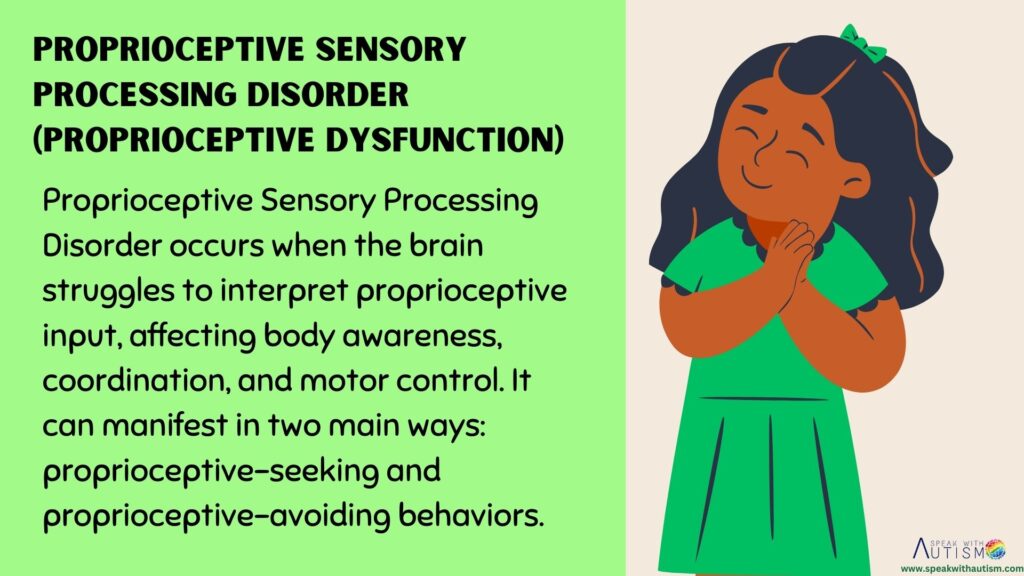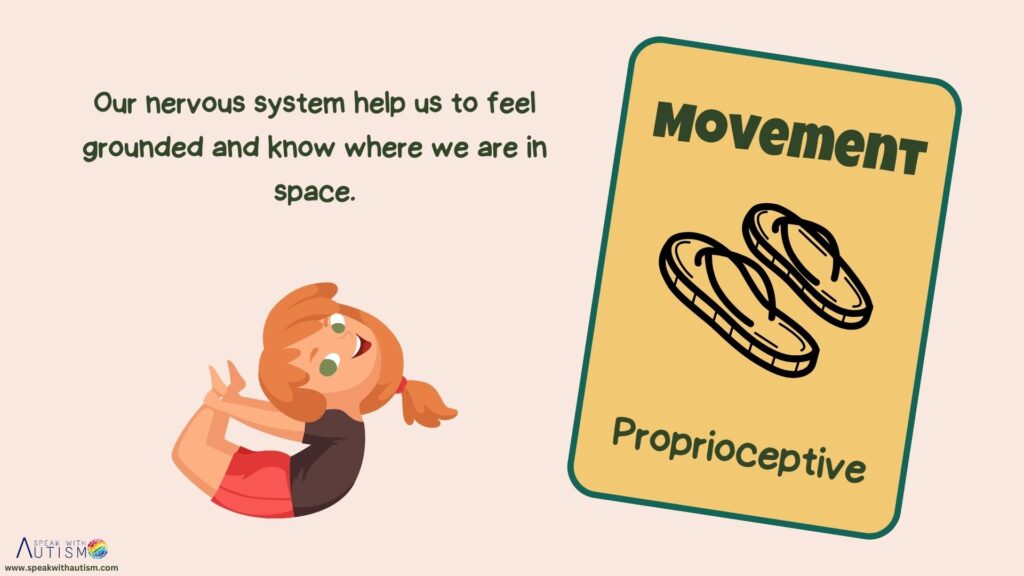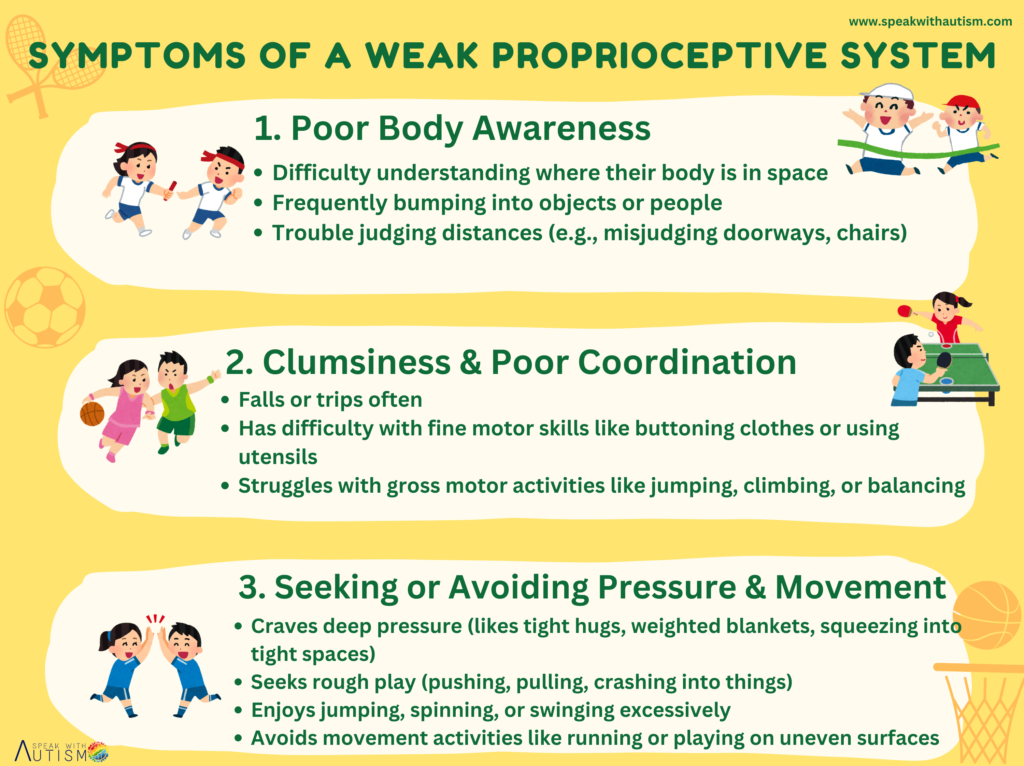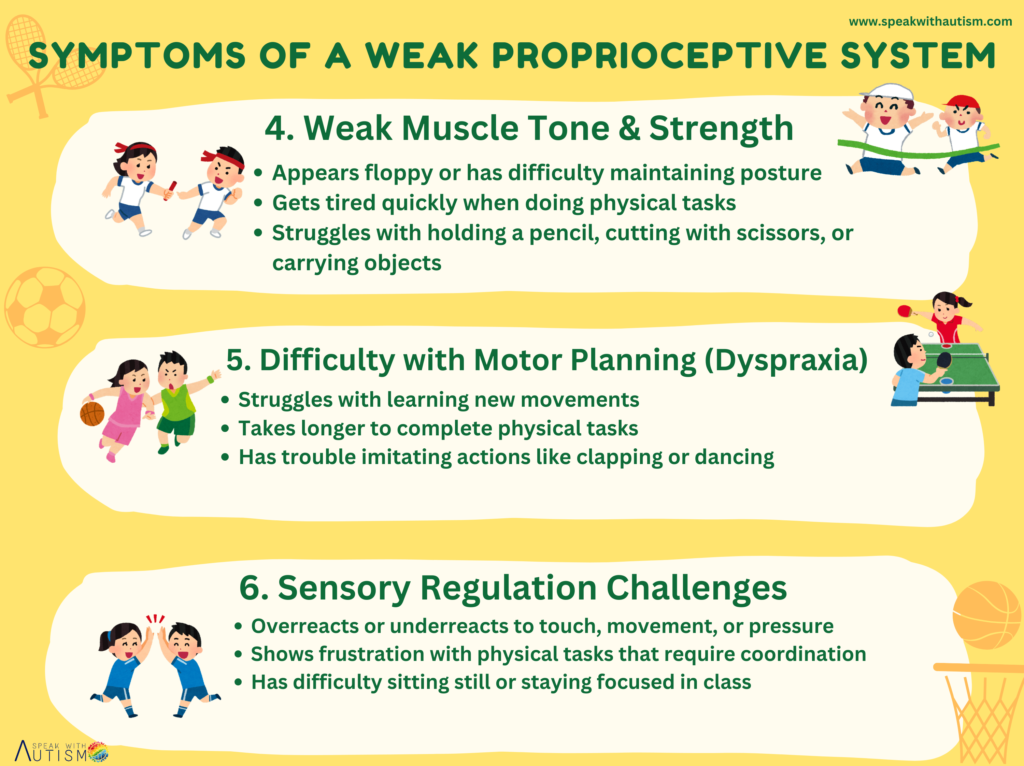Nowadays many parents notice that children of 8-9 years are having difficulty in basic physical skills like catching, hitting, jumping, and climbing. The main reason for this may be the weakness of their sensory system. In this article, we will specifically understand the proprioceptive system and know what effect its weakness has on the skills of children.

Table of Contents
What is the proprioceptive system?

The proprioceptive system is the hidden sense related to our body’s muscles, joints, and tendons. It forms an important connection between the brain and the muscles.
When we are in a certain posture, this system sends signals to our brain about whether our position is correct or not. For example, when we sit straight, our abdominal and spine muscles remain tense, which signals the brain that we are sitting in the correct posture. If this system is weak, it becomes difficult for the child to control his body.
Symptoms of a weak proprioceptive system

The child has difficulty applying the right pressure on the pencil, which affects his writing.
The child has difficulty understanding how much force to throw the ball with.
Hyperactivity – Children keep playing without stopping and do not stay in one place.
Clumsy children, that is, they bump into things or are unable to maintain balance.

How to improve the proprioceptive system?
For young children Activities for Proprioceptive Sensory Processing Disorder
- Crawling – This strengthens the proprioceptive system of children.
- Kneeling – This improves body balance and coordination.
- Body weight exercises – The more children lift their body weight, the more their system will develop.
For older children Activities for Proprioceptive Sensory Processing Disorder
- Ball activities – Play ball throw and catching games with the child.
- Let them lift heavy objects – Let them lift water bottles, vegetable baskets, or other safe heavy objects.
- Child activities – Make the child sit on a mattress or gym ball and do balance exercises.
- Trampoline jumping – Give gradual exposure so that the child does not feel scared.
- Swing – Initially sit on the swing with the child in your lap and gradually increase the speed of the swing.
- See-saw activity – It helps in balance and body coordination.
- Pushing a weighted cart – Helps build strength and body awareness.
- Pulling a resistance band – Engages muscles and improves coordination.
- Jumping on a trampoline – Provides deep pressure and balance control.
- Climbing stairs – Strengthens leg muscles and enhances proprioception.
- Wall push-ups – Simple weight-bearing exercise for sensory input.
- Carrying a weighted backpack – Offers deep pressure and grounding.
- Bear walks on hands and feet – Strengthens core and motor planning.
- Crab walking across the floor – Engages multiple muscle groups.
- Hanging from monkey bars – Builds grip strength and endurance.
- Wheelbarrow walking – Improves upper body strength and coordination.
- Squeezing a stress ball – Enhances hand strength and proprioceptive input.
- Jumping jacks – Provides full-body movement and deep pressure.
- Rolling over a gym ball – Gives calming and organizing input.
- Crawling through a tunnel – Encourages movement and spatial awareness.
- Throwing and catching a weighted ball – Improves motor skills and control.
- Pulling a heavy box with a rope – Strengthens muscles and motor planning.
- Tug-of-war with a rope – Encourages teamwork and heavy work.
- Carrying grocery bags – Incorporates functional heavy work.
- Chewing crunchy or chewy foods – Provides oral proprioceptive input.
- Hugging a weighted blanket – Gives calming deep pressure stimulation.
- Pushing against a wall with hands – Builds upper body strength and deep pressure input.
- Marching in place with high knees – Engages core and improves balance.
- Stacking and carrying heavy books – Provides functional heavy work.
- Pulling a resistance band with legs – Strengthens lower body muscles.
- Jumping rope – Improves coordination and full-body proprioception.
- Carrying a laundry basket filled with clothes – Functional weight-bearing activity.
- Squishing playdough or clay – Strengthens hands and provides deep pressure.
- Climbing up a slide instead of sliding down – Enhances muscle strength.
- Walking while holding a weighted ball – Improves balance and coordination.
- Raking leaves or shoveling snow – Engages upper body and core muscles.
- Scooter board exercises – Promotes heavy work and motor planning.
- Bouncing on a therapy ball – Gives calming deep pressure input.
- Jumping and crashing into pillows or cushions – Provides deep impact sensory input.
- Squeezing into a body sock or stretchy fabric – Enhances body awareness.
- Rolling a therapy ball over the body – Delivers calming deep pressure.
- Pushing a friend or sibling on a swing – Encourages strength and coordination.
- Wrestling or rough-and-tumble play – Provides safe proprioceptive input.
- Balancing on a wobbleboard – Enhances posture and stability.
- Carrying water buckets or watering plants with a heavy watering can – Functional proprioceptive input.
- Holding a plank position – Engages core muscles and body stability.
- Climbing a rope or cargo net – Builds upper body strength and coordination.
- Slamming a medicine ball onto the ground – Provides controlled heavy work.
- Rolling or tumbling on a soft mat – Encourages movement and spatial awareness.
- Playing “superhero push” by pushing against a parent’s hands – Encourages strength and fun engagement.
Conclusion: Proprioceptive Sensory Processing Disorder
Parents should do daily activities with children to strengthen the proprioceptive and vestibular systems. Light exercises and sports improve children’s skills, which improves their body awareness, balance, and motor skills. Regular and directed activities will reduce the child’s hypersensitivity and increase the ability to concentrate.
If your child is too hyper or too timid, then gradually give him exposure to the right activities. This will develop his sensory system and he will move towards becoming self-reliant.
Frequently Asked Questions (FAQ’s)
Why do some 8-9 year olds not know how to catch, rocket hit, jump, and climb?
This may be because their sensory systems are weak, especially the proprioceptive and vestibular systems. These systems help control body movement and balance. When these systems are not developed properly, children have difficulty walking, jumping, catching, and climbing properly.
What is the proprioceptive system and why is it important?
The proprioceptive system is a sensory system connected to the muscles, joints, and tendons of the body that tells the brain what position the body is in. This system helps us to accurately judge our strength and make balanced movements. If it is weak, children may become clumsy and have difficulty holding a pencil with the right pressure, throwing a ball, or maintaining balance.
Why are children hyperactive or unable to control their movements?
When children have weak proprioceptive and vestibular systems, they can react in two ways:
Hypersensitive children: who are afraid of the slightest movement, avoiding slides, swings, or climbing heights.
Hyposensitive children: who seek out excessive movements, such as constantly spinning, jumping, running fast, or climbing walls and furniture.
